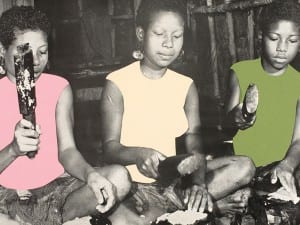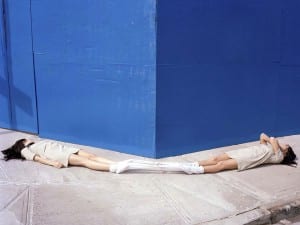A landmark exhibition of Julio Le Parc’s work at Palais de Tokyo, Paris, looks at the pioneer of “Op” and kinetic art’s ongoing contribution to contemporary art.
In April 1972, the artist Julio Le Parc (b. 1928) put his career, momentarily, into the hands of fate. The Museum of Modern Art Paris had just offered him a large retrospective covering works spanning from 1959 to 1972. However, Le Parc, heavily influenced by the general anti-institutional stance amongst artists at the time, could not decide by himself whether or not to accept the offer, so he decided that his young son would, in front of an audience at the museum, flip a coin to determine his answer instead. The coin landed on tails and the exhibition did not take place. This is a well-told story, one that has labelled Le Parc a rebel, a risk-taker and a martyr to his and his fellow artists’ vision.
Le Parc has, since, rarely exhibited in France. His often enlightening, mesmerising and innovative work has been shrouded beneath his rebellion. Due to this, the recently opened exhibition at Paris’ Palais de Tokyo of his work, within the museum’s season of exhibitions entitled Cold Sun, carries with it a certain amount of importance and weight. Curator Daria de Beauvais explains: “We wanted to show him at the Palais because his language is just so compelling. We did not want to have a retrospective or to present him as a historical artist; we wanted to demonstrate that he is an artist of today.” Le Parc is most commonly known for his pioneering work in “Op” (optical) art, a style, set against the backdrop of the 1960s, which is concerned primarily with altering and experimenting with perception through creating illusions. However, despite the inclusion of some of Le Parc’s influential “Op” works from 1959 onwards (such as his illusory black and white “sequence” paintings), the newer works, plus remastered and expanded older pieces – most of which are kinetic light pieces – are some of the most important and effective on show.
Passage-cellule agrandie du labyrinth de 1963 (1963–2013) is one of the more significant remastered works in the show, built on a larger scale and tailored specifically for the space. Strategically placed at the entrance, this disorientating and playful installation, a densely hung collection of full-length mirrors somewhat reminiscent of an amusement arcade or Versailles “House of Mirrors” attraction, acts as a maze-like obstacle or rite-of-passage into the main exhibition (a similar curatorial choice in the 2012 Tate Modern Yayoi Kusama retrospective saw one of Kusama’s famous Infinity Rooms placed at the exit of the exhibition to equal effect). De Beauvais says: “The audience enters the exhibition through this work. It’s a kind of forest of illuminated metal which everyone must pass through to enter the show properly.” The viewer, in being presented with a labyrinth of his or her own endlessly reflected image to navigate, immediately becomes a part of the work: an active participant. This piece sets the tone for the exhibition, throughout which, with clever and simple kinetic constructions, manipulations of light and playful experiments on perception and illusion, the relationship between spectator and artwork continuously remains in a state of flux.
One particular room, the Salle de Jeux (Game Room), a space in which the pieces included demand the interaction or presence of the viewer to have effect, is particularly explorative of the role of the spectator. “This room combines many different formats used by the artist. In this space, we have an unstable ground with distorting mirrors from the 1960s, but also the more political deduction board games from the 1970s. All of these works call for active and thoughtful participation from the visitor, in whom the artist attempts to elicit a different kind of behaviour, transforming him or her into the conductor of the exhibition,” explains De Beauvais. Frappez les Gradés (Punch the Officer) (1971) is included in the Salle de Jeux. This politically influenced work invites the audience to attack a group of inflatable punch bags, upon each of which is depicted a well-dressed figure; these caricature-like illustrations could be read as being representative of the establishment. At the time of the creation of this work (a year from the fateful Paris coin-toss), Le Parc held very strong anti-institutional views. Just three years earlier, in an article entitled Cultural Guerrilla, he wrote: “What is important is no longer the work of art, but rather confronting the cultural system.” In Frappez les Gradés, the viewer is invited to act out Le Parc’s views physically in a comical and theatrical manner. As the figures depicted are not explicitly tied to representation, however, participants are also able to project their own stories onto the bags before attacking them. Again, here, the spectator becomes participant: in this instance, the performer.
Le Parc’s political outlook on institutional art greatly influenced the themes, ideas and concepts of his practice. In the 1960s, he co-founded GRAV (Group for Research in Visual Art), which was a collective that actively rejected the egoist, self-indulgent aesthetics and constraints of abstract expressionism. Through an effort to be neutral, Le Parc became drawn to looking at the illusory capabilities intrinsic to non-representational forms (demonstrated first in his “Op” art) and at the role reversal of artist/spectator/art form. In the resulting work, the focus is not on the artist or the artist’s feelings or subconscious emotions (as in abstract expressionism), but on the spectator, the spectator’s absorption of visual stimuli and the theatricalities of observation (the latter exemplified in Frappez les Gradés). “He wanted his work to be as neutral as possible, for it to not show the hand of the artist. His works are simple, without a lot of theories behind them, because he wants the viewer to be able to grab the work by themselves and to think and act on his or her own accord,” says De Beauvais. Whether in Le Parc’s early illusory “Op” paintings or in his immersive installation works, the viewer is always important; in observing his work, the viewer is situated on an equal, collaborative ground with the artist. “Much of his work depends on the viewer to be activated,” explains De Beauvais.
In the time of GRAV, exploring the role of the artist and spectator was not uncommon. John Cage’s famous piece 4’33” (1952), for instance, consists only of the sounds produced by the audience, not by the silent pianist on stage, and in La Monte Young’s Composition 1960, No 6. (1960), the performers sit on stage listening to and watching the audience. Artists were also experimenting with the game as a medium (e.g Jaroslaw Kozlowski’s Spell Your Name with These Objects (1976), inviting audiences to participate in playful activities, as seen in Le Parc’s Salle de Jeux. However, despite Le Parc’s affinity with artists of this time, he also remains, in both his older and newer works, highly relevant today. De Beauvais explains how his work with light, in particular, continues to be current: “Immersive light work is very much part of the context of current contemporary art. At the time of Le Parc’s first light works, immersive installations were revolutionary, but now I think people are familiar with them – audiences don’t feel like this is something old that they need to regard; rather it is something that they are part of, so Le Parc, even at 84 years of age, remains current.”
There has been a recent intensification of interest in light art. Major exhibitions solely focused upon light include Hayward Gallery’s Light Show, Anthony McCall’s Solid Light Works at Les Abattoirs, Toulouse, and the upcoming Guggenheim, New York, exhibition of James Turrell. Julio Le Parc at Palais de Tokyo fits in quite suitably. The only difference is that Le Parc is not only the contemporary of these other artists; he is also an influence and pioneer in their medium. “Works by Le Parc that are 50 years old could easily have been made today. Numerous artists are influenced by him: James Turrell, Jeppe Hein, Philippe Decrauzat and many others. Sometimes the future lies in the past. I think that is the case with Julio Le Parc,” De Beauvais says. “His examinations of the visual spectrum, movement, light and the relationship between the work and the spectator remain highly pertinent now.”
Some of Le Parc’s concepts and specific areas of interest of can be traced in the works of many other contemporary artists working today. The illusion of solidity in Anthony McCall’s perfect prisms of projected light in Between You and I (2006), for example, can be seen in the angular cuboid outlines of Le Parc’s Lumière visualisée (1962-1981) and in the shifting solidity of Sphere Rouge (2001-2013). In the latter, individual, glistening, red squares of plastic combine to form the shape of a sphere. However, due to the fact that each red square is able to turn independently, flurries of light reflect in random places across the surface of the sphere and destroy the illusion of the collective shape. The sphere moves in and out of perfection indefinitely. The illusion of solidity is similarly lost when the viewer penetrates the walls of McCall’s light prisms.
As well as this, Conrad Shawcross’ Slow Arc Inside a Cube IV (2009) (currently part of Hayward Gallery’s Light Show) explores space and perception in a comparable way to Le Parc’s Lumière en vibration (1968-2012). In Shawcross’ piece, a light source in a geometric, latticed structure of a cube slowly rotates, moving back and forth, to and from the walls of the cube. The shadow of the lattice is projected onto the walls, stretching and growing, and then shrinking down again with the movement of the light. The effect created is as if the room itself is morphing in and out of shape. In Le Parc’s Lumière en vibration, a box in the centre projects horizontal lines onto hung, reflective sheets which crowd the area, pulsating, moving up and down; the space assumes a state of instability.
Despite not explicitly involving audience participation, Le Parc’s light works do subtly elicit different behaviours from viewers and, in quiet ways, still study and play with the role of spectator. In the Salle de Jeux works, and even in the entrance labyrinth, the audience assumes a clear role in the activation of the artwork. However, in pieces such as Continuel-lumière cylindre (1962-2005), where a collection of light flurries forming a circle slowly turn and fade, suspended in darkness, giving the illusion that the lines of light are bending, the viewer does not alter or trigger the artwork at all; he or she remains just an observer. This is also the case with works such as Lumière en vibration and Sphere Rouge. Though the viewer does not alter the artwork in these cases, these artworks do alter something in the viewer, creating serenity and awe, tricking the eyes to see bent light, a solid shape or distortion of space. Olafur Eliasson’s famous The Weather Project (2003), a work in which an orange, glowing sphere of light (representing the sun) was suspended in the Tate Modern’s Turbine Hall, had a similar altering effect on viewers. The Tate floor, for that season, became inundated with viewers lying down for hours at a time beneath Eliasson’s sun as though sunbathing. De Beauvais explains: “In all of his works, Le Parc wants his artistic gesture to be as neutral as possible in order for the visitor to have his or her own experience. He said in 1995, ‘generally speaking, I have tried, through my experiments, to elicit a different type of behaviour from the viewer. This research ranges from simple retinal stimulation to a comparative analysis of the elements of reality. It can go further, to seek, together with the public, various means of fighting off passivity, dependency or ideological conditioning by developing reflective, analytical, creative or active capacities.’”
In Le Parc’s light works, the theatricality seen in his games and labyrinth is diluted into the simple act of observation: an exploration of audience perception (and the manipulation of this perception) of light, movement, depth, solidity and space. This is not so far removed from his early experimentations with perception and illusion in his “Op” works. “His study of the role of spectator has always been a big part of his research,” says De Beauvais. “He explains that what drives him is mainly experimentation and research. What he creates is always very simple so that there is room for the spectator’s feelings too. It’s always very minimal technique with maximum effect.”
Due to the huge span of works included in the Palais de Tokyo exhibition (from 1959-2013), the viewer assumes multiple performative states throughout. Forced at the beginning to become navigator, observer and instigator of disorientation in the mirror labyrinth, once in the main space he or she can be seen as “conductor”, subject of trickery and then, in the most humble and simple role, observer. Julio Le Parc continues until 20May as part of Cold Sun at Palais de Tokyo, Paris. www.palaisdetokyo.com.
Claire Hazelton





